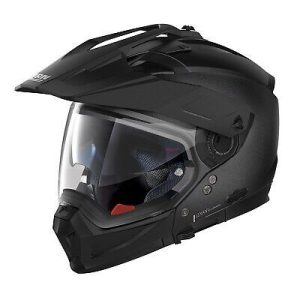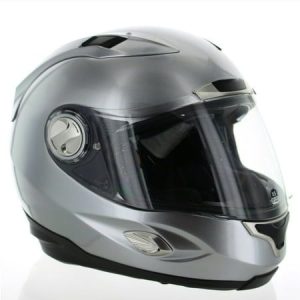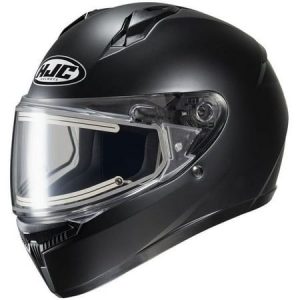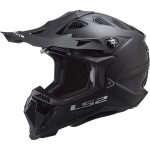Cruising down the open road on a motorcycle is an exhilarating experience, offering a sense of freedom and connection to the world around you. But before you twist the throttle and zoom off, prioritizing safety is paramount. Your helmet is your first line of defense in a crash, and understanding a motorcycle helmet’s lifespan is crucial for ensuring optimal protection.
This comprehensive guide dives into the question of how old a motorcycle helmet can be and equips you with the knowledge to make informed decisions about your helmet’s safety and replacement.
Why Your Helmet’s Age Matters
Motorcycle helmets are designed to absorb impact and protect your head in the event of an accident. However, the materials used in helmets degrade over time, reducing their effectiveness. Here’s why a helmet’s age matters:

- Breakdown of Materials: The protective shell and inner liner of a helmet are composed of materials like plastic and polystyrene foam. Over time, these materials can become brittle and less effective at absorbing impact.
- Loss of Adhesives: The adhesives that hold the helmet’s components together can weaken with age, compromising the helmet’s structural integrity in a crash.
- Ultraviolet (UV) Light Degradation: Exposure to sunlight can accelerate the breakdown of materials in your helmet, especially the outer shell.
While a well-maintained helmet might look functional even after years of use, these internal changes can significantly compromise its ability to protect you in a crash.
Shedding Light on Helmet Lifespan: Recommendations and Regulations
There’s no universally mandated lifespan for motorcycle helmets. However, safety experts and helmet manufacturers generally recommend replacing your helmet every 5-7 years, regardless of condition. Here’s a breakdown of the reasoning behind this recommendation:

- Manufacturer Guidelines: Most reputable helmet manufacturers recommend replacing their helmets after 5-7 years from the date of manufacture (not purchase). This timeframe considers the degradation of materials under normal use conditions.
- Safety Standards: While there are no age restrictions on helmet use in most regions, helmets must meet safety standards set by organizations like the Department of Transportation (DOT) or Snell Memorial Foundation. However, these standards only guarantee a helmet’s safety at the time of manufacture; they don’t account for age-related degradation.
Replacing your helmet every 5-7 years is an investment in your safety. Don’t wait for signs of wear or damage before considering a replacement.
Beyond the Years: Factors Influencing Motorcycle Helmet Replacement
While the 5-7 year timeframe is a general guideline, several factors can influence when it’s time to replace your motorcycle helmet:
- Frequency of Use: If you ride your motorcycle frequently, the helmet’s materials will degrade faster due to exposure to heat, sweat, and sunlight. Consider replacing your helmet more often if you’re an avid rider.
- Storage Conditions: Improper storage can accelerate a helmet’s degradation. Avoid storing your helmet in extreme temperatures or direct sunlight.
- Exposure to Accidents: Even a minor crash can compromise a helmet’s structural integrity. If your helmet has been involved in an accident, replace it immediately, regardless of the visible damage.
- Visible Signs of Wear: Cracks, deep scratches, or loose components are all red flags that your helmet needs replacement. Don’t risk your safety with a damaged helmet.
Inspecting Your Motorcycle Helmet: Spotting Signs of Age and Damage
While the 5-7 year mark is a good starting point, regularly inspecting your helmet can help you determine if it’s time for a replacement even sooner. Here’s what to look for:

- Shell Condition: Carefully inspect the helmet’s outer shell for any cracks, deep scratches, or signs of gouging. These imperfections can compromise the helmet’s ability to absorb impact.
- Inner Liner: The inner liner is crucial for comfort and fit. Check for signs of excessive wear and tear, such as loose stitching, thinning padding, or a foul odor. A worn-out liner can become uncomfortable and less effective at absorbing sweat.
- Visor Clarity: The visor should be clear and free of scratches or excessive cloudiness that can obstruct your vision. Consider replacing a scratched or cloudy visor to maintain optimal visibility while riding.
- Moving Parts: Ensure all the helmet’s moving parts, such as the visor mechanism and chin strap, function smoothly and securely. Replace any malfunctioning components promptly.
A thorough inspection can reveal hidden signs of age-related degradation that might not be readily apparent.
Finding the Right Replacement: Choosing a New Motorcycle Helmet
Once you’ve determined it’s time to replace your helmet, it’s time to find the perfect fit! Here are some factors to consider when choosing a new helmet:

- Helmet Type: There are various motorcycle helmet styles available, each designed for specific riding needs. Popular options include full-face helmets, modular helmets, half helmets, and dual-sport helmets. Research the different types to find the one that best suits your riding style and preferences.
- Safety Features: Look for helmets that meet or exceed safety standards set by organizations like DOT or Snell. Consider additional safety features like a double D-ring closure system for optimal security.
- Comfort and Fit: A comfortable helmet is essential for a safe and enjoyable ride. Ensure the helmet fits snugly but comfortably, without any pressure points. Refer to our previous guide on “How to Measure a Motorcycle Helmet” for proper measurement techniques.
- Ventilation: Proper ventilation is crucial for comfort, especially on hot days. Look for helmets with vents that allow for adequate airflow to prevent excessive sweating.
- Visor Options: Choose a helmet with a visor that offers good clarity and scratch resistance. Consider features like an anti-fog coating or a sun shield for added comfort and visibility.
Invest in a high-quality helmet that provides optimal protection, comfort, and the features you need for a safe and enjoyable ride.
Equipping Yourself for the Road Ahead: Don’t Delay, Replace!
Now that you’re armed with the knowledge of a motorcycle helmet’s lifespan, signs of wear and tear, and factors to consider when choosing a replacement, it’s time to take action! Don’t wait until your helmet shows obvious signs of damage before replacing it.

Here’s how to prioritize your safety and get started on finding your perfect helmet:
- Inspect Your Current Helmet: Give your helmet a thorough inspection, paying close attention to the points mentioned earlier. If you notice any signs of wear or damage, or if your helmet is nearing the 5-7 year mark, consider replacing it.
- Explore Your Options: Research different motorcycle helmet styles, brands, and features to narrow down your choices. Consider visiting a reputable motorcycle gear store to try on helmets and get expert advice on fit and selection.
- Prioritize Protection: Don’t compromise on safety. Choose a helmet that meets the latest safety standards and offers the features that best suit your riding needs.
- Invest in Your Safety: A high-quality motorcycle helmet is an investment in your safety and well-being. Don’t delay – replace your old helmet today and ride with confidence!
Browse Our Extensive Helmet Collection and Ride Safe!


